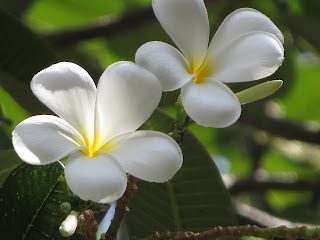Plumeria Flower(araliya flower)
Most people in sri lanka can
identify an Araliya tree no matter how little they know about trees. With its
gnarled branches, long leaves and distinctive flowers, it is easily one of the
most common and identifiable trees in Sri Lanka.The bark is grey and scaly. The
branches have a swollen appearance and thicken towards the ends. A cut made on
any part of the tree will exude a milky, sticky sap. The leaves are smooth and
shiny, upto one foot long with well defined veins. They appear at the ends of
the branches.
The flowers which appear in clusters, again at the end of the branches, are scented. The petals are waxy and the centre of the flower is usually a different colour to the rest of it. For example the white flowers generally have a yellow centre. There are many varieties ranging from deep crimson to orange to white. The flowering season is from March to May but throughout the year the tree usually produces flowers.
The Temple tree is so called
because the scented flowers are used as temple offerings and often the tree is
planted near temples. In India the tree is a symbol of immortality because of
its habit of producing leaves and flowers even after it has been lifted out of
the soil. And so it is often planted near temples and graveyards, “where daily
the fresh creamy blooms fall upon the tombs” (D.V. Cowen, Flowering Trees and
Shrubs in India). The tree has no timber or fuelwood uses. However it is used
for many other purposes in India, if not in Sri Lanka.The milky sap seeping out
of any crack on the tree is used as a counter irritant for rheumatism and
together with sandalwood oil and camphor is a cure for itching. The bark too
has medicinal properties and is used to relieve fever, heal sores and as a
purgative. Heated leaves are used to relieve swellings.
The scientific name is Plumeria obtusa which it gets from the 17th century French botanist Charles Plumier. It is commonly referred to as the Frangipani after the famous fragrance created by Muzio Frangipani. In Sinhala it is known as the Araliya and in Tamil as the Arali or Perungalli.
The Temple tree originated in tropical America and it is not certain whether it was introduced in Sri Lanka by the Portuguese or much earlier. The ladies depicted in the Sigiriya frescoes appear to be carrying flowers very similar to those of the Araliya. If they are in fact meant to be Araliya flowers then the tree would have been introduced 1500 or more years ago.
Today however it is so common that it can be seen in gardens, parks and along roadsides in Colombo and in the rural areas and has come to be regarded as an indigenous tree by some.



ReplyDeleteAAKASH is a leading bamboo biomass renewable energy company engaged in bamboo plantation and creating sustainable environment friendly sources of energy for the use of mankind bamboo energy company in srilanka